
The overall acoustic performance of a room is often managed before and after a fit out has been completed. Here are some simple considerations and practices to ensure that acoustics are maintained at their desired level.
Using our new acoustic report as a guide and reference, you can easily compare and decide on products which meet the appropriate acoustic requirements for your project. By taking account of any product’s acoustic rating you can remove the guesswork and make more informed decisions in relation to how sound will behave in any particular room, when all other variables are also considered.
Sound easily travels over the partition and through a suspended ceiling where it abuts the underside of a suspended ceiling. This is a common source of sound transmission particularly where the ceiling is porous to sound. Partitions should, wherever possible, continue through the ceiling to the structural soffit and be sealed where it meets adjoining surfaces.
Sealing up gaps around the doors and partitions is important to maintaining the integrity of good acoustics. If the gaps can allow air or water to pass through, then sound will be able to as well. A gap as thin as a business card is enough to allow sound to pass through it. Criterion stocks a wide range of acoustic foam tapes and silicone to seal these gaps.
 Image: Deloitte, Perth.
Image: Deloitte, Perth.
The first priority once the fit out is done and a noise problem has been alerted, is to identify the source of the noise and determine if anything can be done to isolate or remove the noise source. In some cases the noise source may be able to be moved. Essentially, the further away from the wall a sound source is, the softer the sound will become. This can be done by repositioning furniture in the room and orienting it away from the wall. The meeting room table or office desk, for example, can be closer to the centre of the room so that when there are conversations the voice can be projected away and the sound can be dispersed.
Two rules of thumb which can be applied are:
Double the distance = a reduction of -6dB
Ten times the distance = a reduction of -20db
Acoustic wall panels made of foam can also double as decorative wall art, depending on the design of the room. These are relatively easy and cheap to install if there is the need to reinforce the walls or ceilings.
The importance of keeping acoustics top of mind is imperative throughout the course of the project, from the planning stages right through to completion. There are factors and variables which can change and affect the performance of acoustics so it is good to keep these basic tips in mind.
Feature image: Channel 9, Perth.

In the world of luxury residential design, every element must serve a dual purpose: stunning visual impact and flawless performance...

When we think of luxury homes, the focus often falls on architectural statement pieces – expansive glazing, bespoke joinery, or curated finishes...